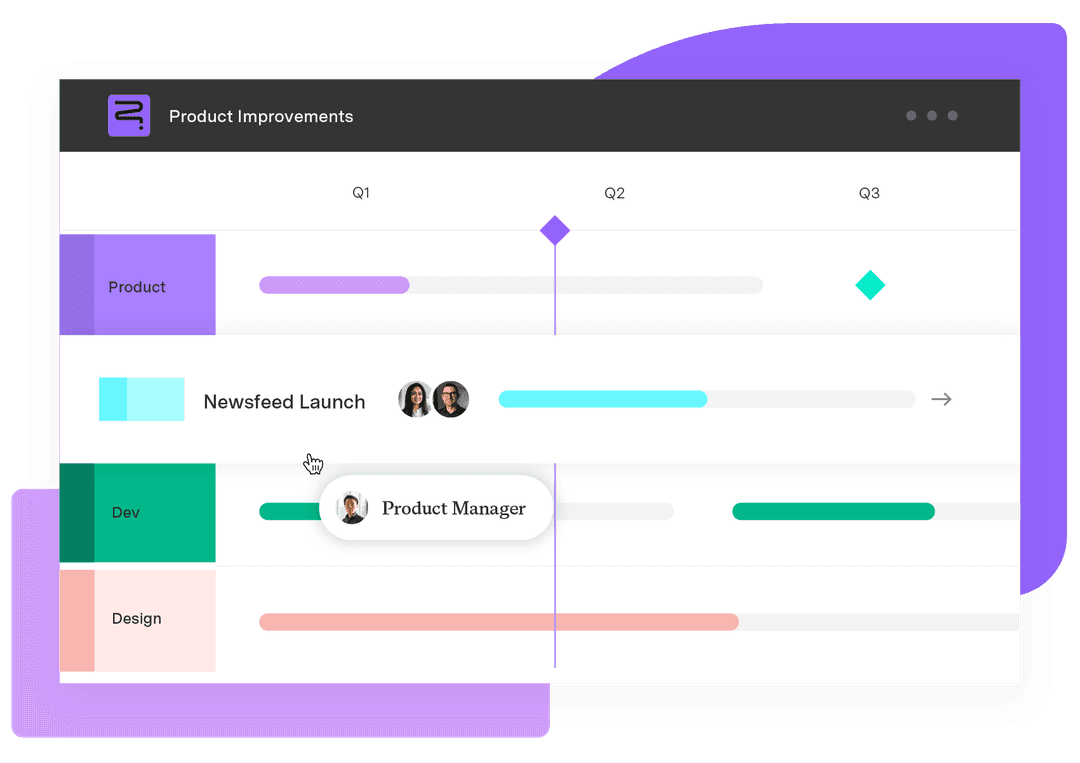Agile PI planning: A guide to successful program increments
Tempo Team
Agile project management methods give project teams much-needed flexibility in a dynamic business environment. In particular, the Scaled Agile Framework (SAFe) prescribes communication and planning events that allow organizations to quickly alter strategies in response to evolving markets and economic conditions.
These events, known as SAFe program increment (PI) planning, provide agile release trains (ARTs) with the necessary guidance to adapt program iterations, backlogs, and objectives. When teams leverage agile PI planning, everyone from product managers to release train engineers and developers is empowered to alter course to address changing audience demands.
Let’s discuss SAFe PI planning and how to implement it.
What’s PI planning?
A program increment in agile is a time period (typically 8–12 weeks) during which working groups, known as ARTs, complete a checklist of predetermined tasks. PI planning events are similar to sprint planning but cover more ground. Instead of working in scrums, PI planning gathers every member of the ART, ensuring their combined efforts contribute to the organization’s long-term vision and goals.
Led by the release train engineer (RTE), ARTs perform the following tasks during PI planning:
Discuss future undertakings, objectives, and releases
Establish the project roadmap for the upcoming 8–12 weeks
Uncover cross-team dependencies
Determine timelines, milestones, and delivery deadlines
Once concluded, the RTE adds the planning event outcomes to the SAFe program board, which acts as the blueprint and single source of truth for the upcoming increment.
In the scaled agile framework, PIs are typically held in person, fulfilling the Agile Manifesto’s requirement of face-to-face communication. However, this isn’t always possible in a remote work environment. Hybrid and distributed agile PI events are becoming more commonplace.
Why agile PI planning is essential for success
PI planning in the scaled agile framework affords companies the adaptability to stay competitive while extending benefits across ART levels. Here are some of its benefits for an agile release train:
1. Alignment
Cross-functional teams may struggle with collaboration, especially when integrating remote workers. One benefit of PI planning is the removal of silos that isolate teams. Gathering in a communal space in person or via teleconferencing allows agile teams to share progress and challenges, fostering alignment and understanding among peers.
2. Clarity
Every PI planning event kicks off with an update on strategic goals and objectives. The report provides clarity for agile teams regarding the value and impact of their corporate contributions.
3. Confidence
Collaboration requires trust. PI planning builds this by bringing together workers from across the organization to mingle, share ideas, and problem-solve. These events strengthen bonds across the ART, improving the productivity of working relationships.
4. Customer satisfaction
Organization-wide alignment with business goals and processes yields more productive and efficient client interactions, improving overall customer satisfaction.
5. Decision-making
PI planning streamlines problem-solving by getting cross-functional teams on the same page, ensuring fast, evidence-based decision-making.
6. Prioritization
Organizational goals and objectives are revealed during PI planning, providing insights that help ART teams prioritize workflows and tasks to deliver the greatest impact.
Different types of agile PI planning events
The Agile Manifesto required teams to gather face-to-face for PI events. However, the advent of remote work and distributed teams changed all that. Now, hosts choose from one of four event formats:
In-person PI planning
The original format requires ART members – RTEs, Scrum Masters, product owners, and developers – to gather for in-person meetings. Attendees use physical tools to capture insights and updates to the SAFe program board.
Distributed PI planning, format 1
Instead of gathering the ART in one place, each agile team gathers to communicate and plan, communicating with other groups using teleconferencing, digital, and in-person tools. This option is productive when travel is impractical or teams operate across state or international lines.
Distributed PI planning, format 2
An ART can conduct a virtual PI planning event, where team members participate entirely remotely, provided the group can access the required technology. Teleconferencing platforms and cloud-based applications allow agile teams to complete planning tasks.
Hybrid PI planning
During a hybrid event, some ART members travel to a central location while others participate online, creating a mixture of remote and in-person attendees. Hosts leverage flexible technologies to successfully organize the event and accommodate participants’ needs according to agile principles.
Key participants in Agile PI planning
To achieve PI planning goals, event participants should include the following stakeholders:
Release train engineers
The release train engineer leads the agile release train, acting as servant leader and coach. The RTE is responsible for planning and facilitating the PI event. RTEs also perform these functions:
Plan and communicate ART calendars
Oversee risks and dependencies
Draft and publish PI objectives based on the team’s input
Monitor progress
Ensure strategic and implementary alignment
Product owners
Product owners are in charge of the product backlog and iteration planning. They communicate management’s vision and goals to the agile team. In addition to contributing to PI planning objectives, product owners accomplish these essential tasks:
Define user stories
Conduct estimations and sequencing
Monitor progress
Create status and KPI reports for stakeholders
Product managers
Product managers support project portfolio development by communicating customer needs and validating team solutions. During PI planning, they ensure management and prioritization of the roadmap by reviewing draft plans and recommending changes based on the management review and problem solving session. They’re also responsible for the following duties:
Present management’s vision and milestones
Define inputs, objectives, and milestones for the next PI planning event
Update the roadmap based on the RTE’s program objectives
Communicate PI event findings and establish objectives
Scrum masters
As the development team’s servant leader, the Scrum master manages day-to-day processes and finds practical means to deliver on PI objectives. During PI planning, Scrum Masters are tasked with these functions:
Estimate team capacity
Finalize objectives
Manage breakout sessions
Participates in confidence votes
Developers
Developers create, implement, and maintain a product or system. During PI planning, they contribute the following actions:
Create and define user stories
Establish acceptance criteria
Identify risks and dependencies
Draft and finalize team PI objectives
Participate in the team confidence vote
What to include in a PI planning agenda
Along with securing space and tools, no pre-PI planning checklist is complete without drafting the agenda. Establishing and communicating the docket helps attendees prepare and allows facilitators to track meeting progress.
Agendas typically include the following elements:
1. Business update
Upper management opens the event by providing an update on economic factors, strategic goals, and plans to meet customer needs.
2. Current vision
The current vision report, drafted by the product manager, addresses high-priority backlog items or the next 10 features in line for development.
3. Expectations
RTEs introduce the planning process to participants, provide hands-on information, and outline expectations and desired outcomes.
4. Capacity breakouts
Breaking away into Scrums, attendees participate in a time-boxed session where they assess team capacity and draft plans to produce the iteration’s expected deliverables and outcomes.
5. Draft review
After the breakout session, teams present plans for the upcoming iteration, outlining:
Capacity
Objectives
Risks
Dependencies
The other ART members offer feedback and recommendations after each presentation.
6. Management review and problem-solving
If the draft review identifies cross-dependencies or limitations in resources, scope, or capacity, RTEs and management gather for a problem-solving session to brainstorm solutions.
7. Risks
The ART collaborates to identify potential risks ahead of the iteration’s launch, categorizing them as one of the following:
Resolved: No longer a threat.
Owned: An ART member assumes responsibility for mitigation.
Accepted: The team agrees a risk is unavoidable.
Mitigated: The team collaborates on solutions to reduce risk impact.
Once they address the threat, attendees assess their confidence level of achieving PI objectives through a vote.
8. Rework
Returning to their breakout locations, teams assess feedback and risks to update their draft iteration plan and achieve a higher confidence vote.
9. Retrospective
Before closing, the RTE conducts a brief PI retrospective to evaluate what worked, what didn’t, and how to improve future planning events ahead of the next increment. They may update their PI planning template to ensure streamlined operations going forward.
Timing and frequency of program increment (PI) planning events
Typically, increments last 8–12 weeks, allowing for 4–6 sprints per increment. To ensure the ART is updated on business strategies and economic developments, most companies set a quarterly PI planning schedule. Timing and frequency depend on program increment length and should account for statutory holidays, but a typical schedule looks like this:
December: Q1 PI planning
March: Q2 PI planning
June: Q3 PI planning
September: Q4 PI planning
By maintaining a fixed schedule, RTEs and other agile release train leaders have plenty of time to prepare for PI events.
Inputs and outputs of PI planning
The success of PI planning depends on quality inputs – materials generated in preparation for the session. These include:
Briefings: The business status report should provide agile teams with the necessary context to make informed decisions.
Roadmap and vision: These documents provide big-picture insight into organizational direction and visions for the future.
Product backlog: This is a prioritized listing of product upgrades and new features to consider during capacity breakouts.
If the group follows PI planning step-by-step, they will generate the following outcomes by the end of the session:
PI objectives: A prioritized list of SMART goals to complete during the upcoming increment, plus delivery commitments from each agile team.
Program board updates: A list of outcomes, timelines, and dependencies for the next increment.
Integrating PI planning into the Scaled Agile Framework
No matter an organization’s size, SAFe PI planning is an integral part of the scaled agile framework. PI planning events are the foundation of agile transformation, driving improved transparency, company alignment, and collaboration.
Planning events encourage visibility and flexibility by bringing together stakeholders from every team within the ART. Teams collaborate to streamline decision-making and enable agility, allowing the organization to outperform the competition.
Post-PI planning: Following up on the planning event
PI planning isn’t over when stakeholders leave the event. Attendees should follow up by participating in a retrospective to accomplish the following objectives:
Discuss what worked, what didn’t, and how to improve
Review objectives and user stories, then update the SAFe program board
Select times and locations for upcoming stand-up meetings and sprint planning sessions
Develop plans to monitor progress toward PI planning goals
Post-PI planning events ensure ART stakeholders are synchronized and aligned with increment objectives. These meetings cover much of the same ground as the PI planning event, including:
Objectives, milestones, and expected timelines
Capacities and dependencies
Risks – whether owned, resolved, accepted, or mitigated
As with PI planning, outcomes undergo a confidence vote to ensure an effective solution. If a plan doesn’t pass the confidence vote, attendees rework it until success is assured.
Give your agile teams the best tools
SAFe PI planning is an intensive, demanding process, but the right tools can make it easier.
Tempo has everything you need for a productive session. Our Strategic Roadmap application streamlines product and project roadmapping. Structure PPM upgrades planning by helping ARTs manage planning and implementation. And Custom Charts for Jira visualizes performance and progress.
Whatever your SAFe PI challenge, Tempo offers solutions that will help you succeed.













































